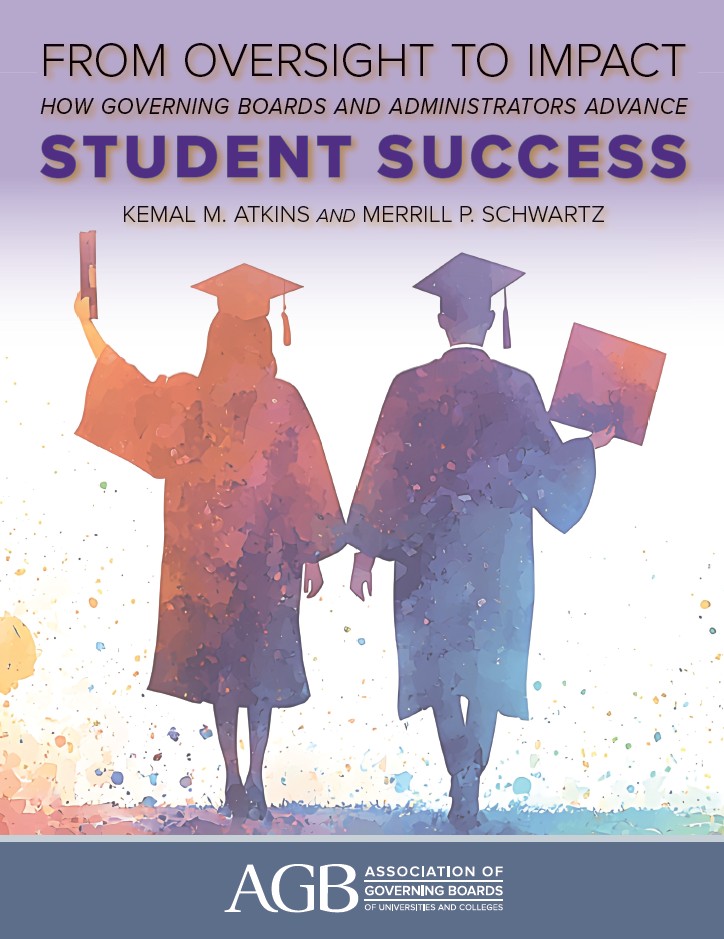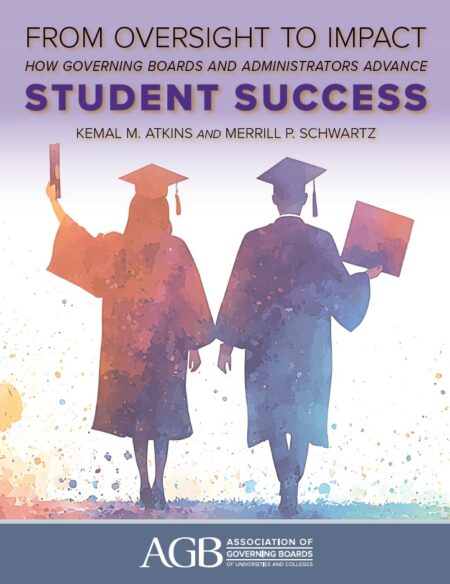
The following case study is based on interviews and information collected in 2025, unless noted otherwise.
Description of the Institution
California State University, San Bernardino [CSUSB] is a preeminent center of intellectual and cultural activity in inland Southern California. Opened in 1965 and set at the foothills of the beautiful San Bernardino Mountains, the university serves more than 20,000 students each year and graduates about 4,000 students annually.
CSUSB reflects the dynamic diversity of the region and has the most diverse student population of any university in the Inland Empire, and it has the second highest African American and Hispanic enrollments of all public universities in California. 70 percent of those who graduate are the first in their families to do so.
The university offers more than 70 traditional baccalaureate and master’s degree programs, education credential and certificate programs, and a doctoral program. In recent years, CSUSB added its first doctorate (educational leadership), engineering program (computer science and engineering), and MFA programs in creative writing and studio art/design. Every CSUSB academic program that is eligible has earned national accreditation. The university also is home to the California Professor of the Year (Stuart Sumida).
The university has an annual statewide economic impact of more than half a billion dollars, along with more than $32 million in yearly statewide tax revenue.
Excerpted from CSUSB, “About CSUSB,” accessed August 27, 2025, https://www.csusb.edu/about-csusb.
Mission, Purpose, Students Served
Description of the Board and System
The CSU Board of Trustees is required by state law to have 25 voting members. Five serve ex officio: the governor, lieutenant governor, speaker of the assembly, state superintendent of public instruction, and the chancellor. Sixteen members are appointed by the governor and confirmed by the state senate; they serve eight-year terms. Additionally, the governor appoints two student trustees chosen from nominees of the California State Student Association, who serve staggered two-year terms; and a faculty trustee chosen from among nominees of the academic senate. Finally, the alumni association appoints one alumni trustee. The alumni and faculty trustees serve two-year terms.43
The CSU system is made up of 23 institutions (transitioning to 22 in 2026)44 serving more than 450,000 students and awarding more than 125,000 degrees annually.
Description of the Governance Structure for Higher Education in the State
California has a unique structure for higher education, developed as the “California Master Plan” in 1960 that created three systems: University of California (research universities), CSU (comprehensive four-year colleges), and California Community Colleges (two-year degrees). There is no coordinating board in the state, but the systems, state and local government, and legislature take actions to coordinate. Direct transfer is one example, started as a pilot in Riverside County with the CSU system and scaled to the state through a bill which was pending the governor’s signature as of late September 2025.45 This includes relationships among CSU campuses, local high schools, and community colleges. Another example was the development of a systemwide general education curriculum. The state legislature rejected a faculty recommendation for a separate general education curriculum for transfer students and prompted the system to create a single general education curriculum for all CSU students.46
Leaders and Contributors to this Case Study
CSU San Bernardino, as of August 2025
- Tomás D. Morales, president
- David Dufault-Hunter, vice president, strategic enrollment management and marketing
- Bryan Haddock, chief of staff and associate vice president
- Katherine Hartley, deputy chief of staff
- Rafik Mohamed, provost and vice president academic affairs
- Robert J. Nava, vice president, university advancement and executive director, CSUSB Philanthropic Foundation; liaison for project
- Paz Oliverez, vice president, student affairs
- Robin Phillips, vice president, human resources
- Samuel Sudhakar, CFO and vice president, finance, technology, and operations
- Ray Watts, associate vice president for philanthropic giving
- Monica Alejandre, secretary and associate vice president, advancement operations
- Lou Monville, chair of the Advocacy Committee, CSUSB Philanthropic Foundation
- Nefertiti Long, vice chair, CSUSB Philanthropic Foundation
- Diego Rendon, president, Associated Students Inc; student trustee, CSUSB Philanthropic Foundation
CSU
- Carson Fajardo, student trustee, CSU Board of Trustees; former president, Associated Students Inc; former student trustee, CSUSB Philanthropic Foundation
- Andy Jones, executive vice chancellor and general counsel; secretary of the CSU Board of Trustees
- Dilcie Perez, deputy vice chancellor academic and student affairs, CSU
Strategic Plan Focused on Student Success
CSU used the 2024–2025 academic year for the “Year of Engagement” to research and develop a systemwide student-success framework. The new plan, CSU Forward, was launched in September 2025. This was also a “year of engagement” for the board, with agenda items on student success at each meeting. The presentation at the November 20–21, 2024, meeting of the CSU board’s committee on educational policy emphasized the importance of increasing persistence of students and graduation rates. Key metrics and goals included increasing freshmen four-year and six-year graduation rates, graduation rates for transfer students, and eliminating the gap in these rates for Pell Grant recipients and historically underrepresented students. This is important in terms of the institution’s mission but also has financial impacts on graduates’ lifetime earnings, the state economy and tax revenue, and CSU’s funding.47
The CSU educational policy committee’s presentation to the board on September 9, 2025, included a final report on the Year of Engagement and details for the Student Success Framework, including “The CSU Promise: New Student Experience” (see Figure 2), new metrics and goals, and an implementation strategy. Each metric is aligned with goals in the strategic plan (see details). In addition to continuing to track metrics on enrollment, retention, and graduation (disaggregated by student demographics), new outcome metrics and goals were introduced to measure performance for undergraduate students and postgraduation milestones (job placement, net cost of attendance, access and affordability, student satisfaction, experiential-learning participation rates, alumni engagement, and career earnings two years, five years, and ten years after graduation). The plan also includes strategies to identify and remove barriers in administrative practices and systemwide policies. Although there are ambitious system-level goals for each of the new and continued metrics, institutional goals will reflect the mission and student characteristics of each of the system’s 22 universities.48
A partnership with Educational Testing Service was also announced at the September 9, 2025, board meeting, which will test a career-navigation tool for students’ career planning at seven CSU campuses. The goal is to implement the resource systemwide to support the promise that every graduate will have a first-career job or path to further study.49
Figure 2: The CSU Promise
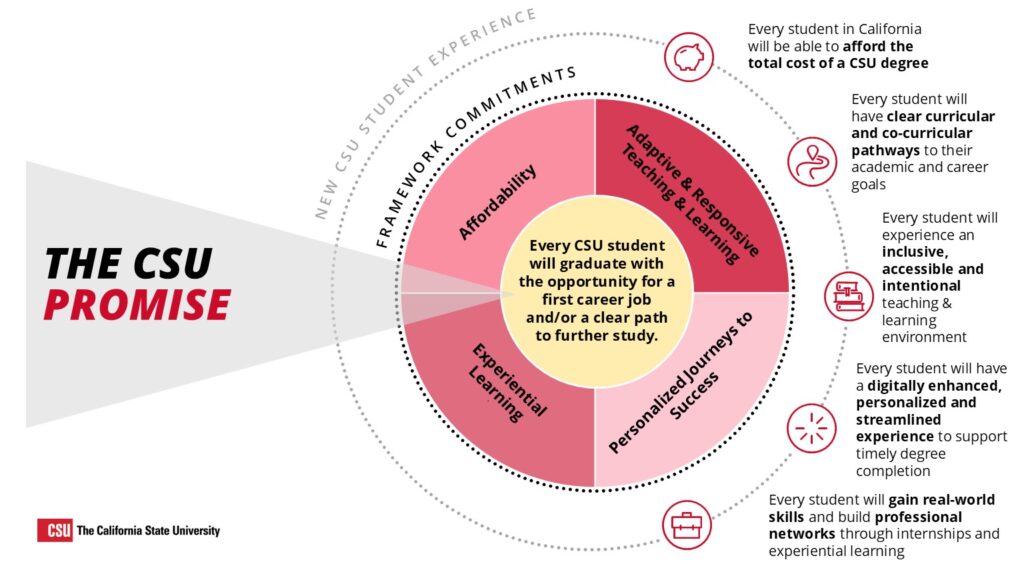
Credit: CSU Board of Trustees, “Year of Engagement: Student Success Report Framework, Final Report,” PowerPoint Presentation, September 7–10, 2025.
The vision for the new CSU system’s strategic plan, “Advancing Higher Education’s Essential Value,” concludes with, “This plan establishes a multifaceted approach to mobilizing coordinated action with transparent accountability while holding firm to our vision that every student succeeds.” The plan includes these four objectives (explained in more detail):
- Economic Mobility Engine
- Sustainable Affordability
- Employer of Choice
- Statewide Impact
The plan also includes these five key performance indicators:
- Value of the CSU Degree
- Affordability and Access
- Maximizing California’s Investment
- Premier Workplace
- California’s Competitive Advantage
How progress will be measured is detailed in the plan with three-year milestones set for each of the four performance objectives, with numerical goals.50
The milestones for Objective 2: Sustainable Affordability are:
- “Commit to student outcomes,” with progress toward goals of 50 percent four-year graduation rates and 72 percent six-year graduation rates.
- “Strengthen affordability,” with the goal that 100 percent of students from families earning under $75,000 graduate debt-free.
- “Demonstrate operational efficiency,” with implementation of systemwide shared services and infrastructure.
- “Achieve funding equity,” with advocacy for state funding equal to CSU’s services and value.
- “Create systemwide student access,” with the goal of enabling 25 percent of students to access courses and programs online across the universities in the system.51
Strategies for student success emphasize the need to exploit the capabilities of the CSU system through collaboration among the system’s 22 universities, as well as through technological advances, and systemwide data collection and analytics. Leadership to foster change and institutional transformation are part of the plan to ensure CSU’s capacity to achieve the plan’s goals, including enhancing policy and regulatory capacity.
As the system’s plan states, “The future of California begins with thriving students. And thriving students begin with [CSU].”52
CSUSB Strategic Plan 2023–2028
The number one goal in the CSUSB strategic plan is student success. Outcomes for this goal include pedagogy in curricular and co-curricular experiences that is responsive and culturally relevant, enhancing individuals’ abilities to succeed as college students and lifelong learners, and enhancing their sense of belonging. Among the strategies to achieve these outcomes are identifying and removing barriers in institutional policies and practices, strategic enrollment management, facilitating access to resources, providing orientation and basic education for first-year and transfer students, mental health services, culturally relevant library resources, increased funding for summer credits, mentoring and outlines of course pathways, and collaboration across divisions to provide holistic services. Evident throughout the description of strategies is an awareness that the institution must change to meet student needs.
Key Data, Metrics, and Dashboards
CSUSB has a long record of successfully welcoming students into college, with strong second-year retention rates that consistently place it close to or above national norms for public universities. In the mid-2010s, CSUSB’s second-year retention exceeded 85 percent, well above the national average, and even today it retains nearly 80 percent of students into their second year, which is comparable to the national benchmark for four-year public institutions. Within the CSU system, where the average is about 83 percent, CSUSB is performing competitively, especially given the distinctive demographics and needs of its student body.
Like other institutions, CSUSB has seen more modest retention into the third and fourth years, reflecting the broader challenges students face as they progress toward graduation. Even so, recent stabilization in the third-year and fourth-year trends suggests that the university’s student success initiatives are helping to slow earlier declines. The story here is one of strength in helping students transition into college, coupled with new opportunities to extend that same level of support through the later years.
CSU has invested in data-management systems and requires regular submission of data on enrollment, retention, and graduation at four years and six years, disaggregated by student demographic characteristics and campus. President Morales said the CSUSB campus reports 55 metrics to the board on student success. Data are publicly available online and display longitudinal data starting in 2014, searchable by a variety of variables, by institution, with comparisons for selected institutions and totals for the system. CSU trend data on graduation and persistence are available back to 2000.
Data Dashboards are available online for:
- Applications and Admissions (for undergraduate and graduate students).
- Degrees Issued (by degree level and type).
- Enrollment (by level, discipline, campus, and student ethnicity).
- Graduation Rates (Full-time first-time freshmen, transfers, and continuing rates for science, technology, engineering, and math degrees).
- Labor Market Outcomes (employment and earnings of graduates by campus, major, degree level, transfer status, and year; trend data available for time intervals, years since degree, and earnings premium compared to high school graduates by student demographics, and by industry).
- Student Origin (public or private California high school, other source in California, or other/unknown).
- Teaching Credential Enrollment (students in teacher-preparation programs).
- Teaching Credential Issued (five-year trend data on new and renewed credentials).
Figure 3: Full-time, First-time Freshmen Retention Rates by Cohort
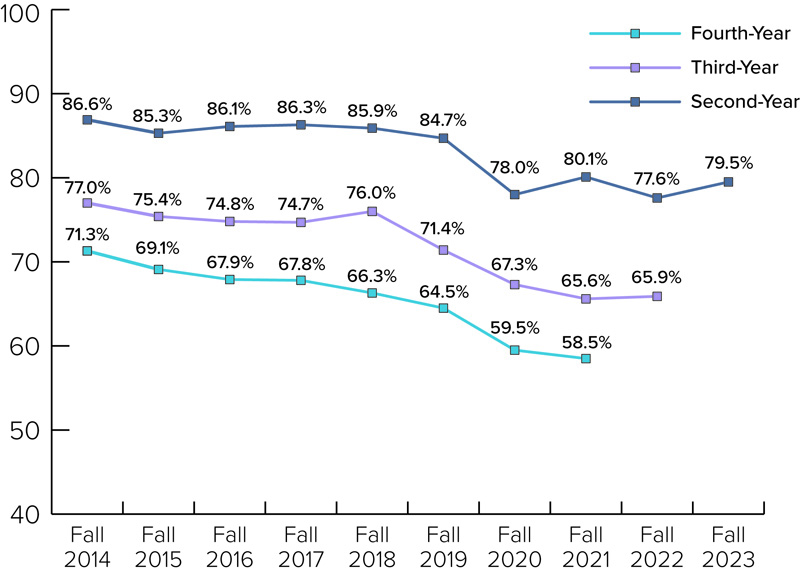
Credit: CSUSB
Figure 4: Full-time, First-time Freshmen Graduation Rates by Cohort
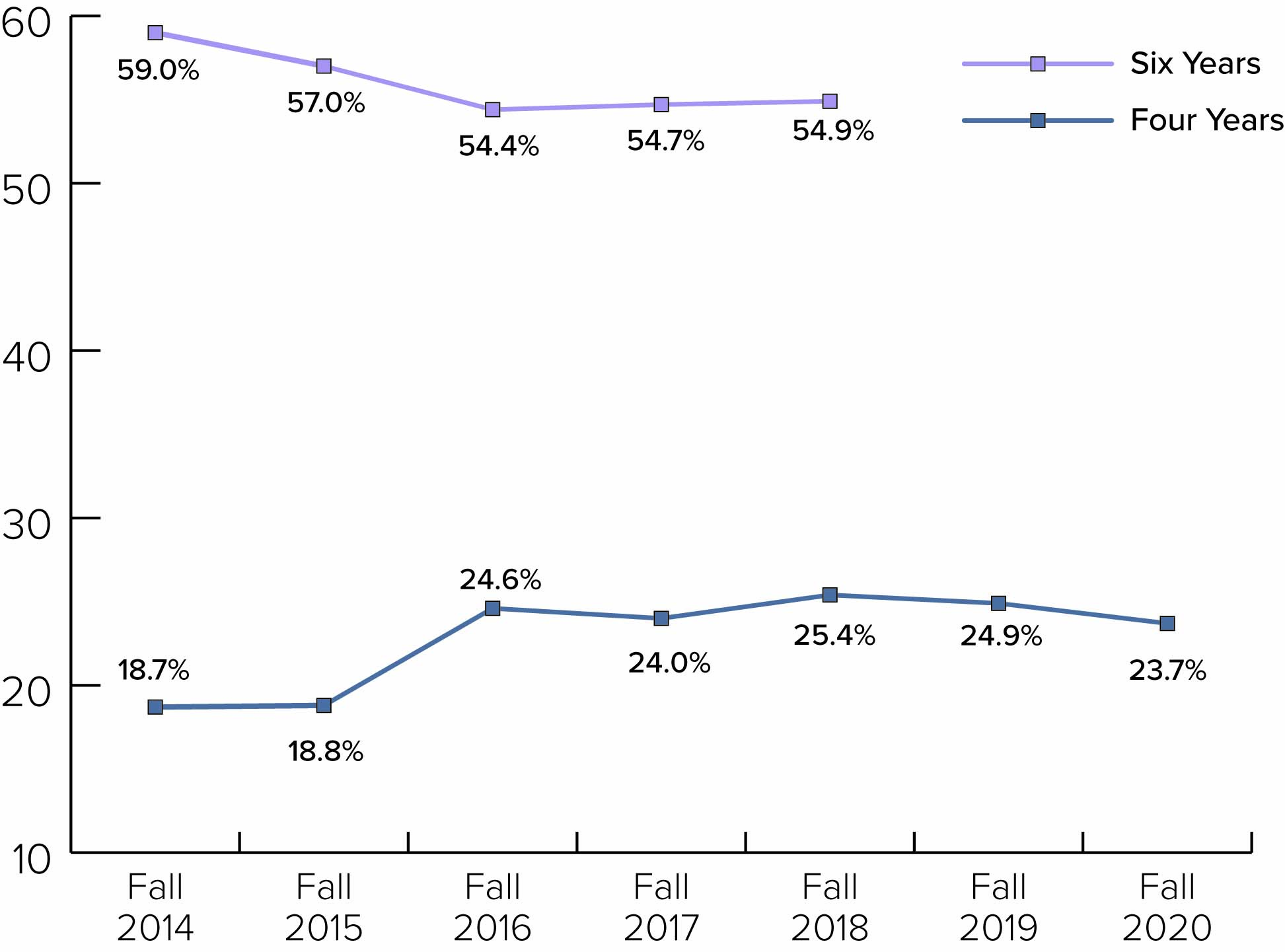
Credit: CSUSB
Figure 5: First-Time Freshmen Mean Unit Load
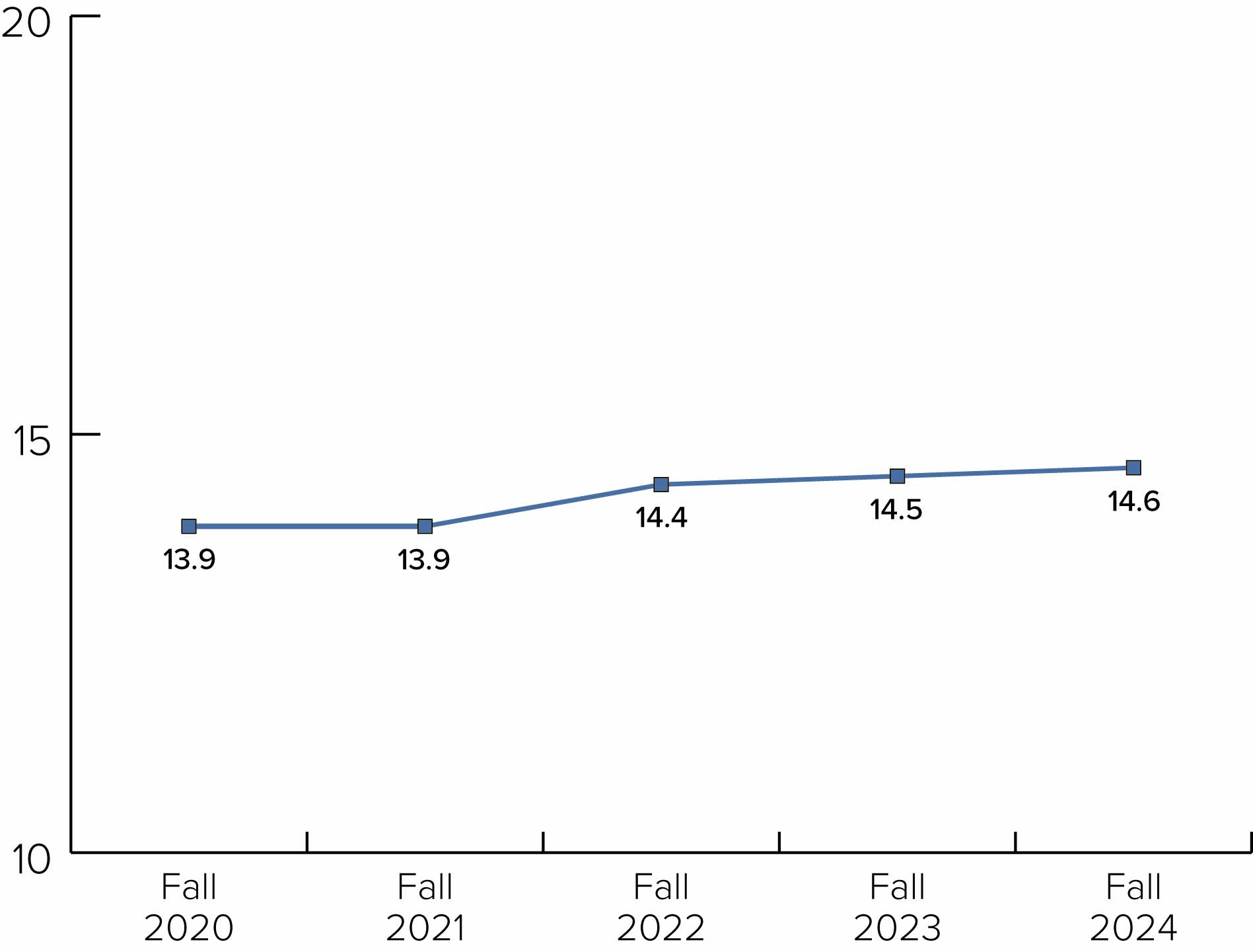
Credit: CSUSB
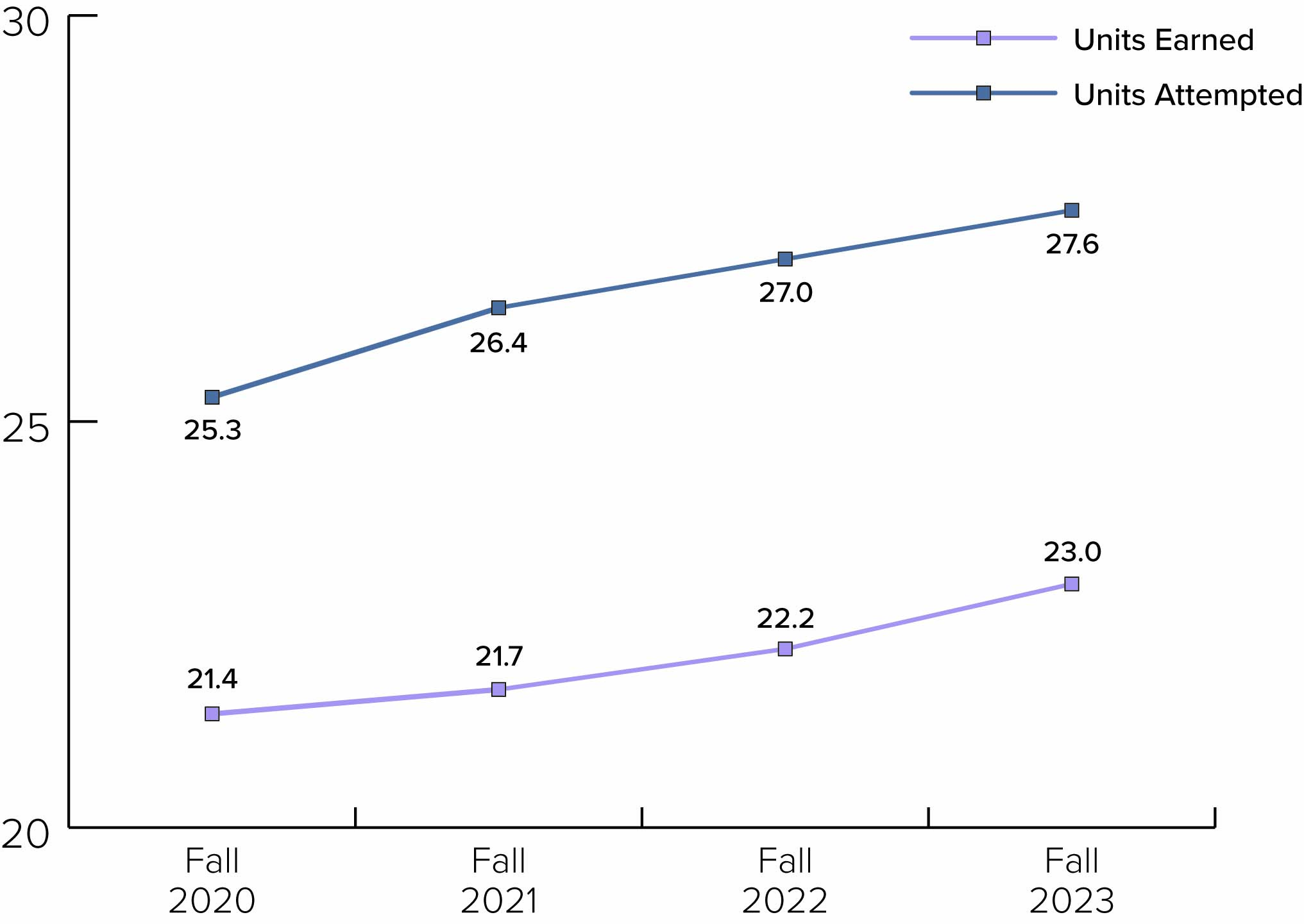
Credit: CSUSB
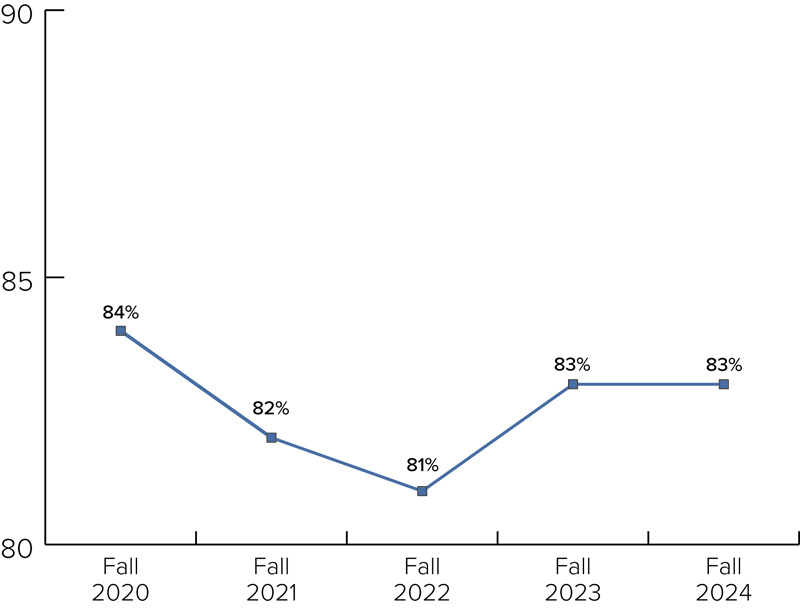
Note: Golden Four general education requirements include: Critical Thinking, Oral Communication, Quantitative Reasoning, and Written Communication.
Credit: CSUSB
Figure 8: First-Time Freshmen Fall-to-Spring Retention
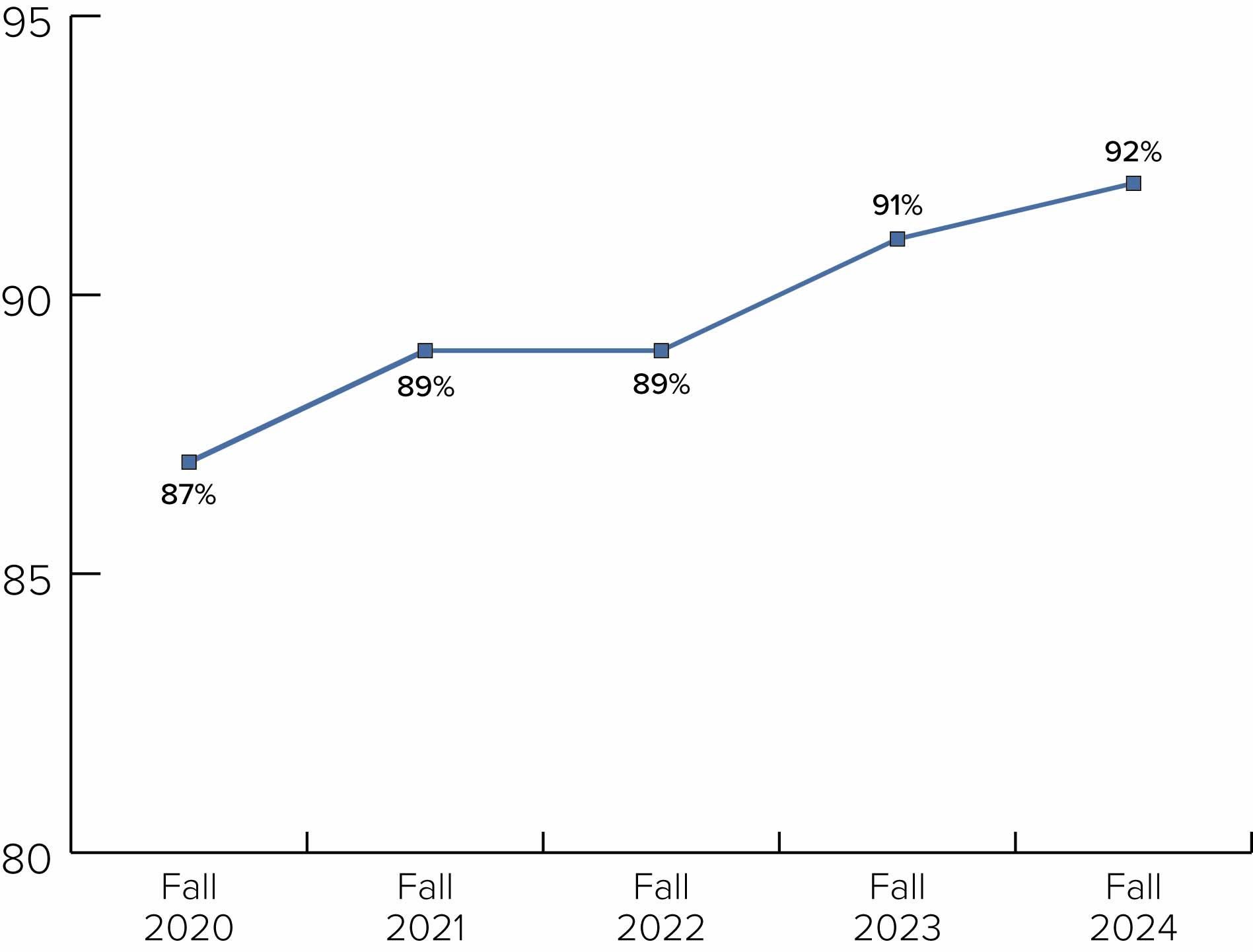
Credit: CSUSB
Description of the State
California is experiencing dramatic cuts in the state budget for 2025–2026, including changes in funding to higher education. The governor signed a budget on June 27, 2025, that deferred 3 percent of funding to the next fiscal year with the option for loans to restore funds.53 CSU board meetings on May 20, 2025, and July 22, 2025, included discussions of loan options, the impact of funding levels on the budget, and unavoidable increases in costs for contracts, energy, and health care. CSU Chancellor Mildred Garcia reported that the system will implement an 8 percent cut in operating expenses for the chancellor’s office and cuts of 3 percent for the rest of the system.54
Despite these budget concerns, the chancellor highlighted progress on development of a new draft strategic plan, with four strategic objectives that prominently featured student success (emphasis added in bold):
- Strengthen CSU as a premier engine for economic mobility and workforce resilience through flexible and technology-enhanced learning experiences to dramatically improve student success.
- Prove higher education value through financial resilience and operational effectiveness grounded in a commitment to student success.
- Establish CSU as an employer of choice through professional excellence that advances system transformation in service of student success.
- Build CSU’s unified statewide impact and community connection through strategic system integration focused on long-term student success.
Among the key metrics for measuring success of the strategic plan are four-year and six-year graduation rates, percentage of low-income students who graduate debt-free, and employment rates at 12 months after graduating.55
The following information from the California systems’ websites provides useful context.
System-by-system Details
- CSU
- University of California (UC)
- California Community Colleges (CCC)
Higher Education Structure
- Three public segments (CSU, UC, CCC), each with its own governing board; no statewide coordinating board.64
- How many institutions are in the public systems:
- CSU 23; UC 10; CCC 116. (Total public campuses/colleges = 149.)65
- Is there a coordinating board?
- No.66
- How many governing boards?
- 3 (CSU Board of Trustees, UC Board of Regents, CCC Board of Governors).67
- Total population served across all boards: Approximately 2.86 million students. (UC >295,000; CSU >460,000; CCC approximately 2.1 million.)68
Table 1: Higher Education Structure
|
System |
Description |
Number of Institutions |
Students Served |
Governing Board |
Website |
|---|---|---|---|---|---|
|
CSU |
Nation’s largest and most diverse four-year public university system; 23 universities and 7 off-campus centers. |
23 universities (transitioning to 22 in 2026) |
>460,000 |
CSU Board of Trustees |
|
|
UC |
The world’s leading public research university system, with 10 campuses, 6 medical centers, and 3 national labs. |
10 campuses |
>295,000 |
UC Board of Regents |
|
|
CCC |
Largest higher education system in the U.S., offering two-year degrees, transfer pathways, and workforce training. |
116 colleges |
Approx. 2.1 million |
CCC Board of Governors |
For more information, visit AGB’s state profiles.
Barriers to Student Success
CSU prides itself on educating “America’s new majority, comprised of low-income students, students of color, first-generation students, adults, and students from all walks of life seeking brighter opportunities.”69 The student body for CSU varies by campus but overall includes 51.9 percent of students from underrepresented minorities. Nearly half of CSU students receive Pell Grants, and nearly one-third are first-generation college students. CSU enrolled 461,612 students in fall 2024, an increase of more than 2 percent compared with the previous year. CSU sees itself as an engine of opportunity for the state; 87 percent of freshmen are from California high schools, and 94 percent of its students are from California.70
CSUSB enrollment in 2024 was 17,900,71 75 percent of whom are traditionally underserved students,72 and over 40 percent are first-generation college students.73 As of 2023, approximately half received Pell Grants.74
Growing Inland Achievement, a leader in coordinating regional K-16 services to expand educational opportunity, partnered with the CSU system, analyzed grades of high school students (grades 9 to 12), and identified a significant increase in students in need of supplemented instruction in general education courses in math or English. One challenge for CSU is that its state funding is based on the number of students, not on their level of preparedness or student needs. A funding formula that reflects student characteristics could better address the need for additional resources for student-support services.
Rafik Mohamed, CSUSB’s provost, identified these primary goals for the campus: increase graduation rates, decrease time to degree, and eliminate gaps in these metrics among student groups. He cited several barriers identified in CSU’s Graduation Initiative 2025: Curricular pathways did not make sense, there were no roadmaps for students to follow in registering for courses in their majors, schedules were not built for multiple years of study in particular fields, and first-time full-time students had a 13 percent four-year graduation rate. Many students accumulated 200 or more credits, wasting time and resources for students and CSU. This initiative led to building new curricular pathways to degrees supported by better advising.75
CSUSB’s institutional research team was essential in identifying bottlenecks and other problems. For example, there was a 55 percent DFWI rate in introductory biology, and the number one indicator for students stopping out was failing one or two courses in the first year. The provost engaged chairs and department heads to work with faculty, provide data, and develop solutions to increase student success. Providing data on DFWI rates was a new practice, and faculty members were not aware of the patterns. The addition of supplemental instruction and mandatory discussion sections were a difference maker in student performance. Although many students were skeptical, they participated in these activities after professional academic advisers were used to reach out to students in need of more support and tell them, “This class has supplemental instruction.” There was a successful partnership among institutional research, information technology, and student advisers devoted to students’ academic success. The partners deployed a digital learning management system that provided early warnings for students at risk.
However, in a meeting with the CSUSB president’s cabinet, they recognized that there was an unmet need because of an insufficient amount of aid provided to low-income students, a need that had not been measured and addressed. For students to thrive and not merely survive, aid must address unmet need.
Mental health and student success are correlated, especially for low-income students who need help but cannot afford services elsewhere and might have to wait weeks for an appointment with a health professional. With more resources, the provost would like to invest in more staff to help students with outreach and mental health services. CSUSB has seen a huge spike in years since the pandemic in the need for mental health services and is struggling to keep pace with the need.
Actions Taken That Made a Difference
Leadership/Governance
Tomás Morales was appointed president of CSUSB in 2012, the fourth president of CSUSB since its founding in 1965. One of the characteristics of effective leaders is their long service. He also served as president of the College of Staten Island in the CUNY System from 2007 to 2012. His experience in CUNY, a system with two-year and four-year institutions, made him especially sensitive to the importance of relationships with the colleges from which prospective students transfer.
CSU receives students from over 100 community colleges in the CCC system. One significant change in the past for CSUSB (and other CSU campuses) was changing its calendar from quarters to semesters in fall 2020 to align itself with the academic calendars of California high schools and community colleges, thus aiding dual-enrollment and transfer students. CSUSB also has an automatic admissions arrangement for qualified high school students in the region, started as a pilot with a local school district. As of September 2025, a bill was pending with California’s governor (SB-640 2025–2026)76 which would adopt such an arrangement as a statewide policy for CSU, CCC, and California high schools. The CSU system supported both the calendar change and the automatic admissions program.
President Morales also serves as president of the CSUSB Philanthropic Foundation. He typically includes an educational component at each foundation board meeting, and during a two-day retreat in Palm Desert in 2025, he held a special study session focusing on enrollment management and student success. A valuable resource for such educational activities is AGB’s A Guide to Strategic Board Retreats in Higher Education and its chapter “Advancing Student Success for Governing Boards” (AGB, 2025).
Foundation board members we interviewed reported that data provided by the president on student retention, progression, and graduation, along with presentations by students with personal stories about challenges to their academic success, then informed foundation priorities and the volunteer service of board members. Additionally, members of the president’s cabinet serve as members of the foundation board, contributing to alignment of the foundation and institution in planning and priorities. Foundation board members were actively involved as mentors for students, provided financial-literacy training, sponsored paid internships, contributed to food pantries and clothing drives, and attended events on campus.
A common refrain among cabinet members and from the president was “no silos”—student success is everyone’s business. The president holds an annual leadership retreat on student success for about 150 campus leaders, director-level and up, that includes department chairs, deans, the lead custodian, and student leaders. Cabinet members felt the most compelling part of the day was the panel of students. The students were candid about things many of the staff members did not know.
Students’ Basic Needs
A holistic approach to treating basic human needs as part of academic needs was a common practice among our case-study institutions, including CSUSB. Student success could be derailed by many factors; timely interventions could prevent students from stopping out or allow them to return. The CSU system adopted as part of Graduation Initiative 2025 several changes in food services, housing, financial aid, and other policies to meet students’ basic needs that were implemented by each campus.
In November 2022, CSU implemented the CSU Basic Needs Initiative—a plan to address students’ food and housing insecurity with food pantries, emergency housing and grants for rental assistance, case managers, a program called Basic Needs Ambassadors (training for faculty, staff, and students), clothing resources, financial-literacy workshops, and other resources throughout its campuses. Meeting students’ basic needs inside and outside the classroom was recognized as critical to student success.77
The members of the board of the CSUSB Philanthropic Foundation were well informed about challenges students face, and students’ basic needs inform board members’ fundraising priorities and volunteer activities. This was especially helpful to the university after new and unexpected needs arose when the COVID-19 pandemic hit in 2020.
Data-based Decision-making
President Morales said CSUSB has made significant investments in institutional research and data analytics, including tracking such student characteristics as freshman or transfer status (50 percent of entering students are transfers), along with the high school or community college from which they came. Each CSU campus reports progress on key metrics to the system at least twice a year, including four-year and six-year graduation rates, and two-year and four-year graduation rates for transfer students—all disaggregated by student demographic characteristics (Pell recipient, race, sex, and so forth). The cabinet uses dashboards and detailed information on students to guide decisions on enrollment and retention strategies, as well as advising.
Strategic Enrollment Management
CSU will launch its strategic enrollment management plan in fall 2025. The goals presented to the system’s education policy committee at the May 19–21, 2025, board meeting included:
- Charting a new course to improve access and enrollment opportunities.
- Elevating CSU’s role as California’s and the nation’s university of choice.
- Providing recommendations to support data-informed enrollment decisions.78
The plan will address access and retention, student demand and workforce needs, lifelong learning opportunities, leveraging “systemness” for enrollment resources and relationships, and building needed infrastructure for the system and institutions. Data management and communication are essential strategies.
Key elements of the strategic enrollment management plan include improvements in financial aid and direct admissions policies and practices. (See “Affordability/Access.”)
Cradle to Career Data System
The state has engaged with several entities to create a “Cradle to Career” data system. This longitudinal data system was created by legislation in 2019 with the goal of connecting data on K-12 schools, colleges, social services, and employment to better understand outcomes for Californians, from early childhood to adulthood, while protecting individual privacy.79 Data tools are designed for use by students, families, educators, advocates, and researchers. It is intended to support planning and transitions for students and facilitate data-informed decision-making.80
Holistic Advising
Holistic advising considers the full range of a student’s academic, personal, and career needs, creating a more supportive and integrated experience. By moving beyond course selection to include conversations about goals, challenges, and well-being, advisers build stronger connections that encourage persistence and completion. This approach has helped CSUSB identify barriers early, connect students with appropriate resources, and foster a sense of belonging. As a result, there have been improvements in retention rates, timely graduation, and student satisfaction.
The CSUSB Student Success Initiative includes a range of offices, including Academic Success and Undergraduate Advising, that connects services for academic advising, peer advising, supplemental instruction, mentoring, tutoring, writing, and advising in the major.81 There is also information available through the CSUSB Advising Podcast, with over 100 episodes.82
A refrain from several cabinet members was the challenge of bringing students back on campus following the pandemic. A point of pride for the CSUSB Palm Desert campus was securing funding for a new student services building, which will provide a gathering place and centralized services for students, including an advising/tutoring center, career center, expanded library, health care, study spaces, and dining. The advocacy committee of the CSUSB Philanthropic Foundation played a key role in making a convincing and timely case for state funding. The building is scheduled for completion in 2026 or 2027.
Relationships and experience developed during the long service of CSUSB President Morales and then-foundation CEO Robert Nava and Advocacy Committee Chair Lou Monville’s service as past chair and trustee emeritus of the CSU Board of Trustees helped in their advocacy efforts. Robert Nava and Lou Monville described the community’s coordinated efforts for securing needed state funding for the new student-services building in “The Role of Advocacy and Community Relations for Foundation Boards,” in Trusteeship, May/June 2024:
Affordability/Access
Direct Admissions: CSU conducted a successful direct-admission pilot program for seniors graduating in 2025 from high schools in Riverside, California. CSUSB is nearby and one of several colleges receiving applicants from these high schools. As noted previously, a bill (SB-640) in the California legislature would establish a process for automatic admissions to CSU for qualified high school seniors and Associate Degree for Transfer (ADT) recipients throughout California. The bill was approved unanimously by the legislature’s higher education committee in July 2025, by the full legislature in September 2025, and, as amended, describes this effort as a way to remove barriers, especially for first-generation college students unfamiliar with the application process.84
Note that an earlier policy established the ADT, which created pathways for degree-seeking transfer students to attain junior status at a CSU campus, and graduate with 120 credits and a bachelor’s degree in the same major. The ADT pairs specific California community colleges and CSU campuses by major.85
Financial Aid: The CSU Strategic Workgroup on Financial Aid reported to the system’s Joint Educational Policy and Finance Committees at the May 19–21, 2025, board of trustees meeting, summarizing policy changes for the 2025–2026 academic year. These were in response to a resolution of the system’s board in January 2024, highlights of which were:
- Address the total cost of attendance.
- No student should be precluded from enrolling by cost.
- Maximize state and federal aid.
- Support recruitment and success.
- Align with CSU graduation and success goals.
- Provide greater consistency across campuses in aid administration.
Policy Changes Effective 2025–2026
- Full tuition grants are available to eligible undergraduates with annual household incomes of up to $125,000.
- The State University Grant (SUG) is expanding to include cost of attendance awards.
- Greater emphasis is placed on maximizing federal and state financial aid, including Cal Grants.
- Postbaccalaureate SUG awards will be proportional to postbaccalaureate student enrollment on each CSU campus.
Progress Made: Infrastructure
- Improving the student financial aid experience through:
- Online and mobile document submission.
- Clear and consistent financial aid award notices and communications aligned with the College Cost Transparency Initiative’s guidelines.
- Transitioning to a new, student-friendly scholarship application.
- Exploring centralized or multicampus financial aid processing.86
Notes
43 California State University, “About the Board of Trustees,” accessed August 27, 2025, https://www.calstate.edu/csu-system/board-of-trustees/Pages/about-the-bot.aspx.
44 California State University, “Campuses,” accessed September 26, 2025, https://www.calstate.edu/attend/campuses.
45 California Legislative Information, “Bill History—SB-640 Public postsecondary education: admission, transfer, and enrollment,” accessed September 29, 2025, https://leginfo.legislature.ca.gov/faces/billHistoryClient.xhtml?bill_id=202520260SB640.
46 A Master Plan for Higher Education in California, 1960–1975, (Sacramento: California State Department of Education, 1960), https://www.ucop.edu/acadinit/mastplan/MasterPlan1960.pdf.
47 California State University, “CSU Forward: A New Strategic Plan for the CSU,” accessed October 14, 2025, https://www.calstate.edu/Strategic-Planning-for-the-CSU.
48 California State University, “Board of Trustees Agenda,” accessed September 26, 2025, https://www.calstate.edu/csu-system/board-of-trustees/Pages/agenda.aspx.
50 California State University, “CSU Forward: Thriving Students, Thriving University, Thriving California,” accessed September 23, 2025, 4–5, 15, https://www.calstate.edu/Strategic-Planning-for-the-CSU/Documents/csu-strategic-plan-2025.pdf.
53 Neal Wong, “CSU, UC 2025–26 funding fully restored with state loans, other points from CA budget,” Golden Gate Express, July 1, 2025, https://goldengatexpress.org/112964/campus/csu-uc-2025-2026-funding-fully-restored-with-state-loans-other-points-from-ca-budget/.
54 California State University, “Committee on Finance,” July 21–23, 2025, https://www.calstate.edu/csu-system/board-of-trustees/past-meetings/2025/Documents/July-21-23-2025-Committee-on-Finance.pdf.
55 California State University, “Sova—Special Presentation,” July 21–23, 2025, https://www.calstate.edu/csu-system/board-of-trustees/MeetingHandouts/July%2021-23,%202025/BOT%20VERSION-CSU%20Strategic%20Objectives_FINAL.docx.pdf.
57 CSUSB, “The CSU System,” accessed September 26, 2025, https://catalog.csusb.edu/csu-system/.
58 California State University, “Students,” accessed September 26, 2025, https://www.calstate.edu/csu-system/about-the-csu/facts-about-the-csu/Pages/students.aspx.
59 California State University, “About the Board of Trustees,” accessed September 26, 2025, https://www.calstate.edu/csu-system/board-of-trustees/Pages/about-the-bot.aspx.
60 University of California, “Campuses & locations,” accessed September 26, 2025, https://www.universityofcalifornia.edu/campuses-locations.
61 University of California, “Board of Regents,” accessed September 26, 2025, https://regents.universityofcalifornia.edu/.
62 California Community Colleges, “Key Facts,” accessed September 26, 2025, https://www.cccco.edu/about-us/key-facts.
63 California Community Colleges, “Board of Governors,” accessed September 26, 2025, https://www.cccco.edu/About-Us/Board-of-Governors.
64 “California State Profile,” Education Commission of the States, accessed September 26, 2025, https://www.ecs.org/wp-content/uploads/CaliforniaPSG2020.pdf.
65 California State University, “Campuses”; CSUSB, “The CSU System”; and California Community Colleges, “Key Facts.”
68 University of California, “About Us,” accessed September 26, 2025, https://www.cccco.edu/about-us/key-facts; California State University, “Students”; and California Community Colleges, “Student Enrollment and Demographics,” accessed September 26, 2025, https://www.cccco.edu/About-Us/Chancellors-Office/Divisions/Research-Analytics-Data/data-snapshot/student-demographics.
69 California State University, “Factbook 2025,” accessed August 28, 2025, https://www.calstate.edu/csu-system/about-the-csu/facts-about-the-csu/Documents/facts2025.pdf.
70 California State University, “Enrollment,” accessed August 28, 2025, https://www.calstate.edu/csu-system/about-the-csu/facts-about-the-csu/enrollment.
71 California State University, “Trend by Campus: San Bernardino,” accessed August 28, 2025, https://tableau.calstate.edu/views/SelfEnrollmentDashboard/EnrollmentSummary?iframeSizedToWindow=true&%3Aembed=y&%3AshowAppBanner=false&%3Adisplay_count=no&%3AshowVizHome=no.
72 California State University, “Student Demographics: San Bernardino,” accessed August 28, 2025, https://tableau.calstate.edu/views/SelfEnrollmentDashboard/EnrollmentSummary?iframeSizedToWindow=true&%3Aembed=y&%3AshowAppBanner=false&%3Adisplay_count=no&%3AshowVizHome=no.
73 California State University, “Student Demographics: San Bernardino, Parent Education Level,” accessed August 28, 2025, https://tableau.calstate.edu/views/SelfEnrollmentDashboard/EnrollmentSummary?iframeSizedToWindow=true&%3Aembed=y&%3AshowAppBanner=false&%3Adisplay_count=no&%3AshowVizHome=no.
74 Pell data not yet available for 2024. California State University, “Pell Recipients: San Bernardino, Percentage of Students Receiving Pell,” accessed August 28, 2025, https://tableau.calstate.edu/views/SelfEnrollmentDashboard/EnrollmentSummary?iframeSizedToWindow=true&%3Aembed=y&%3AshowAppBanner=false&%3Adisplay_count=no&%3AshowVizHome=no.
75 California State University, “Graduation Initiative 2025,” accessed September 30, 2025, https://www.calstate.edu/csu-system/why-the-csu-matters/graduation-initiative-2025.
76 California Legislative Information, “Bill Status—SB-640 Public postsecondary education: admission, transfer, and enrollment,” accessed September 29, 2025, https://leginfo.legislature.ca.gov/faces/billStatusClient.xhtml?bill_id=202520260SB640.
77 California State University, “Student Well-Being & Basic Needs,” accessed August 28, 2025, https://www.calstate.edu/impact-of-the-csu/student-success/basic-needs-initiative/pages/default.aspx.
78 California State University, “May 19–21, 2025,” accessed September 29, 2025, https://www.calstate.edu/csu-system/board-of-trustees/past-meetings/2025/Pages/May-19-21-2025.aspx.
79 California Cradle to Career Data System, “Our Mission & Vision,” accessed August 28, 2025, https://c2c.ca.gov/mission-vision/.
80 California Data System, “Cradle-to-Career Data System: Final Report to the Legislature,” June 2021, https://cadatasystem.wested.org/wp-content/uploads/2023/03/Cradle-to-Career-Data-System-June-2021-Legislative-Report_7.7.21.pdf.
81 CSUSB, “Student Success Initiative: Advising & Retention,” accessed August 28, 2025, https://www.csusb.edu/ssi/advising-retention.
82 CSUSB, “CSUSB Advising Podcast,” accessed August 28, 2025, https://csusbadvising.buzzsprout.com/1215218/episodes.
83 Robert J. Nava and Lou Monville, “The Role of Advocacy and Community Relations for Foundation Boards,” Trusteeship 32, no. 3 (May/June 2024), https://agb.org/trusteeship-article/the-role-of-advocacy-and-community-relations-for-foundation-boards/.
85 California State University, “Associate Degree for Transfer Major & Campus Search,” accessed August 28, 2025, https://www.calstate.edu/apply/transfer/pages/associate-degree-for-transfer-major-and-campus-search.aspx.
86 CSU Strategic Workgroup on Financial Aid, “CSU Board of Trustees Joint Committee on Educational Policy and Finance, Agenda Item 3,” PowerPoint Presentation, May 19–21, 2025, https://www.calstate.edu/csu-system/board-of-trustees/MeetingHandouts/May%2019-21,%202025/The%20CSU%20Strategic%20Workgroup%20on%20Financial%20Aid.PDF.


